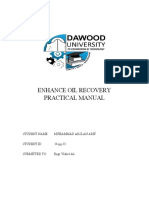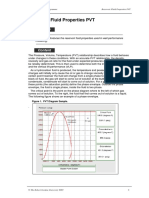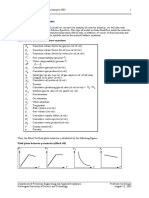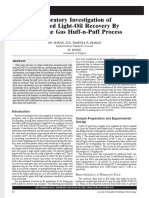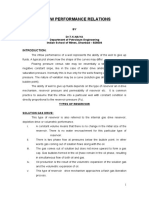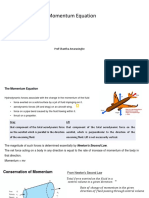KRPC PDF
KRPC PDF
Uploaded by
Yamal E Askoul TCopyright:
Available Formats
KRPC PDF
KRPC PDF
Uploaded by
Yamal E Askoul TOriginal Title
Copyright
Available Formats
Share this document
Did you find this document useful?
Is this content inappropriate?
Copyright:
Available Formats
KRPC PDF
KRPC PDF
Uploaded by
Yamal E Askoul TCopyright:
Available Formats
TPG4150 Reservoir Recovery Techniques 2014 1
Handout note 3: Review of relative permeabilities and capillary pressures
REVIEW OF RELATIVE PERMEABILITIES AND CAPILLARY PRESSURES
Oil-water systems
Both drainage and imbibition curves may be required in studies of oil-water system, depending on the
process considered. Although most processes of interest involve displacement of oil by water, or
imbibition, the reverse may take in parts of the reservoir due to geometrical effects, or due to changes in
injection and production rates resulting in reversals of flow directions. Therefore, drainage curves may
be required. Also, the initial saturations present in the rock will normally be the result of a drainage
process at the time of oil accumulation. Thus, for initialization of saturations, the drainage capillary
pressure curve is required.
Starting with the porous rock completely filled with water, and displacing by oil, the drainage relative
permeability and capillary pressure curves will be defined:
Kr Pc
Drainage
process
oil
Sw =1 water
oil
Pcd
Sw Sw
Swir 1.0 Swir 1.0
Reversing the process when all mobile water has been displaced, by injecting water to displace the oil,
imbibition curves are defined:
Kr Pc
Imbibition
process
oil
water Sw= Swir
water
Sw Sw
Swir 1-Sor Swir 1-Sor
The above curves are typical ones for a completely water-wet system. For less water-wet systems, the
capillary pressure curve will have a negative part at high water saturation. The shape of the curves will
depend on rock and wetting characteristics.
Norwegian University of Science and Technology Professor Jon Kleppe
Department of Petroleum Engineering and Applied Geophysics 10.09.14
TPG4150 Reservoir Recovery Techniques 2014 2
Handout note 3: Review of relative permeabilities and capillary pressures
Oil-gas systems
Normally, only drainage curves are required in gas-oil systems, since gas displaces oil. However,
sometimes reimbibition of oil into areas previously drained by gas displacement may happen.
Reimbibition phenomena may be important in gravity drainage processes in fractured reservoirs.
Starting with the porous rock completely filled with oil, and displacing by gas, the drainage relative
permeability and capillary pressure curves will be defined:
Pcog
Kr
Drainage gas oil
process
oil
So =1 gas
Pdog
So So
Sorg 1-Sgc Sorg 1.0
If the process is reversed when all mobile oil has been displaced, by injecting oil to displace the gas,
imbibition curves are defined:
Pcog
Imbibition
process
gas
kr oil
Oil So = Sorg
So So
Sorg 1 Sgro Sorg 1 Sgro
The shape of the gas-oil curves will of course depend on the surface tension properties of the system, as
well as on the rock characteristics.
Three phase systems
Since we now have three phases flowing, we need to define the relative permeabilities and capillary
pressures anew. Although the following functional relationship not always are valid in practice, we will
here use the conventional definitions for a completely water wet system with no contact between gas
and water phases. Thus, the parameters below are functions only of the saturations indicated:
k rw (S w )
k rg (S g )
k ro (S w , S g )
Pcow (S w )
Pcog (S g )
Except for the relative permeability to oil, k ro , these parameters may be measured in two-phase
measurements since they depend on one saturation only. In the discussion of three-phase relative
permeability to oil, k ro , we will start with typical two-phase oil-water and oil-gas relationships:
Norwegian University of Science and Technology Professor Jon Kleppe
Department of Petroleum Engineering and Applied Geophysics 10.09.14
TPG4150 Reservoir Recovery Techniques 2014 3
Handout note 3: Review of relative permeabilities and capillary pressures
Kr Pcow
oil
water
Sw Sw
Swir 1-Sorw Swir 1-Sorw
Kr Pcog
gas
oil
Pdog
So So
Sorg 1-Sgc Sorg 1.0
The two oil relative permeability curves are two phase curves. However, as indicated above, in a three-
phase flow situation, the oil relative permeability would be a function of both water and gas saturations.
Plotting it in a triangular diagram, so that each saturation is represented by one of the sides, we can
define an area of mobile oil limited by the system's maximum and minimum saturations (which not
necessarily are constants). Inside this area, iso kro curves may be drawn, as illustrated below:
100% gas
Sor
minimum liquid
saturation under
gas displacement
0.1
0.2
0.4
0.6
0.8
100% water 100% oil
minimum oil plus Swir
gas saturation under
water displacement
In principle, k ro may be measured in the laboratory. However, due to the experimental complexity of
three-phase experiments, we most of the time construct it from two phase oil-water k row and two phase
oil-gas k rog . The simplest approach is to just multiply the two:
k ro = k rog k rog .
However, since some of the limiting saturations in three phase flow not necessarily are the same as for
two phase flow, this model is not representative. For instance, the minimum oil saturation, S or , for
three phase flow is process dependent and a very difficult parameter to estimate.
The so-called Stone-models may be used for construction of three-phase relative permeability curves.
A variety of other models exist, but these have been the most commonly used models. For the purpose
of illustration, we will describe Stone's model 1 and model 2.
For Stone's model 1, we define normalized saturations as
Norwegian University of Science and Technology Professor Jon Kleppe
Department of Petroleum Engineering and Applied Geophysics 10.09.14
TPG4150 Reservoir Recovery Techniques 2014 4
Handout note 3: Review of relative permeabilities and capillary pressures
S o S or
S oD =
1 S wir S or
S w S wir
S wD =
1 S wir S or
Sg
SgD =
1 S wir Sor
Then we define the functions
k row
w =
1 S wD
k rog
g = .
1 S gD
The three phase oil relative permeability as constructed my Stones model 1 may now be defined as
k ro = S oD w g
Please note that the above formulas assume that end point relative permeabilities are 1. If this is not the
case, the relative permeability formula must be modified accordingly.
Stone's model 2 does not require the estimation of S or , as it attempts to estimate it implicitly by its
formulation. The model simply is
k ro = (k rog + k rg )(k row + k rw ) (krw + k rg ) .
In this model, S or is defined at the point where k ro becomes negative. The two models of Stone predict
quite different k ro 's in many cases, and one should be very careful in selecting which model to use in
each situation.
Norwegian University of Science and Technology Professor Jon Kleppe
Department of Petroleum Engineering and Applied Geophysics 10.09.14
You might also like
- PVT Measurements: L GasDocument10 pagesPVT Measurements: L Gasthaiha13112003No ratings yet
- Wettability and Capillary PressureDocument39 pagesWettability and Capillary PressureJames BourneNo ratings yet
- OFMDataConnectorForPetrel2011.1 UserGuideDocument26 pagesOFMDataConnectorForPetrel2011.1 UserGuideYamal E Askoul TNo ratings yet
- SOLITON TECHNOLOGIES Questions With AnswersDocument18 pagesSOLITON TECHNOLOGIES Questions With AnswersVeeraragavan Subramaniam79% (14)
- Impes Method 2Document13 pagesImpes Method 2David ReyesNo ratings yet
- Note6 GG KG KDocument13 pagesNote6 GG KG KMizanNo ratings yet
- EOR Mechanisms PDFDocument63 pagesEOR Mechanisms PDFFebri DemuseNo ratings yet
- Saturated Oil-Gas Simulation - Impes Solution: o Os GS So oDocument12 pagesSaturated Oil-Gas Simulation - Impes Solution: o Os GS So oArlette Ramirez ValdesNo ratings yet
- Lecture 6 - Principle of PEDocument45 pagesLecture 6 - Principle of PEkurddoski28No ratings yet
- Dan 3Document14 pagesDan 3Adanenche Daniel EdohNo ratings yet
- Reservoir EngDocument24 pagesReservoir EngRizwan FaridNo ratings yet
- Solubility and Displacement Behavior of A Viscous Crude With CO2 and HydrocarboDocument6 pagesSolubility and Displacement Behavior of A Viscous Crude With CO2 and HydrocarboDânChơiNo ratings yet
- Pete 357 Reservoir Petrophysics: Week 4Document132 pagesPete 357 Reservoir Petrophysics: Week 4sarkodie kwameNo ratings yet
- Volumetric Estimation of Fluid Reserves: V (1 S) 7758 N stb B φ − =Document3 pagesVolumetric Estimation of Fluid Reserves: V (1 S) 7758 N stb B φ − =Ali HijaziNo ratings yet
- Note10 Reservoir SimulationDocument2 pagesNote10 Reservoir SimulationIkmal ZahrawaniNo ratings yet
- Reservoir Fluid Properties RequiredDocument25 pagesReservoir Fluid Properties Requiredninoska217608No ratings yet
- SLIDE7-Gas Condst ResDocument14 pagesSLIDE7-Gas Condst Resolaseye100% (1)
- Tech Reservoir KravReservoirDocument5 pagesTech Reservoir KravReservoirkhansaNo ratings yet
- Eor Manual 32 PDFDocument19 pagesEor Manual 32 PDFarslansamarNo ratings yet
- Gas Cap Oil ReservoirDocument10 pagesGas Cap Oil ReservoirJoseph YepezNo ratings yet
- Fluid Saturation by U.B. PdeuDocument31 pagesFluid Saturation by U.B. PdeuSumit Patel 99No ratings yet
- MccainDocument23 pagesMccainCarlos Orley Gil AmayaNo ratings yet
- 195103-MS Simulation and Performance of Immiscible WAG Pilots in Mauddud Reservoir Using Three Phase Relative Permeability With HysteresisDocument22 pages195103-MS Simulation and Performance of Immiscible WAG Pilots in Mauddud Reservoir Using Three Phase Relative Permeability With HysteresisHadi Ali ALMeftahNo ratings yet
- DF2 - Reservoir Fluid PVT PropertiesDocument3 pagesDF2 - Reservoir Fluid PVT Propertiesadnan0307No ratings yet
- Pressure Gradients and Fluid ContactsDocument7 pagesPressure Gradients and Fluid ContactsAli HijaziNo ratings yet
- 10 Relative PermeabilityDocument13 pages10 Relative Permeabilitysirvan MzbNo ratings yet
- Chapter 3-1 Reservoir Rock and Fluid Properties-20220904Document34 pagesChapter 3-1 Reservoir Rock and Fluid Properties-20220904Apri YansyahNo ratings yet
- Fluid Saturation, S : Total Volume of Fluid Void VolumeDocument3 pagesFluid Saturation, S : Total Volume of Fluid Void VolumeHakimi HarisNo ratings yet
- SLIDE7-Gas Condst ResDocument14 pagesSLIDE7-Gas Condst ResAnonymous nztG1AGvNo ratings yet
- Intechopen 82278Document23 pagesIntechopen 82278Alex HariucNo ratings yet
- WaterfloodDocument42 pagesWaterfloodAlfano Prawira HutomoNo ratings yet
- 7 - Primary Recovery Mechanism PDFDocument30 pages7 - Primary Recovery Mechanism PDFGambas OrakNo ratings yet
- Fluid Properties: PVT Properties of Crude Oils: 1. Oil Formation Volume Factor, BDocument6 pagesFluid Properties: PVT Properties of Crude Oils: 1. Oil Formation Volume Factor, BAli HijaziNo ratings yet
- PVT Sample Taking From SeparatorDocument23 pagesPVT Sample Taking From SeparatorRizwan FaridNo ratings yet
- Nodal Analysis - TAMUDocument53 pagesNodal Analysis - TAMUAhmad FaizilNo ratings yet
- ENM200 Subsurface: Reservoir Engineering: Fluid PropertiesDocument6 pagesENM200 Subsurface: Reservoir Engineering: Fluid PropertiesAli HijaziNo ratings yet
- 7 Three Phase SeparatorsDocument45 pages7 Three Phase SeparatorsShamsiNo ratings yet
- Oil Water SimulationDocument25 pagesOil Water SimulationsifatNo ratings yet
- Chemical EOR S2 1Document199 pagesChemical EOR S2 1Amry Sitompul100% (1)
- Reservoir Drive Mechanisms: CVDP DVDocument9 pagesReservoir Drive Mechanisms: CVDP DVAli HijaziNo ratings yet
- Topic 18 - Reservoir Drive MechanismsDocument10 pagesTopic 18 - Reservoir Drive MechanismswevansNo ratings yet
- Mek4450 Ife Day1 Kha PDFDocument31 pagesMek4450 Ife Day1 Kha PDFInspection EngineerNo ratings yet
- Tech Reservoir MBE MatbalDocument5 pagesTech Reservoir MBE MatbalFaheemNo ratings yet
- PVT Exercise 1 - Volumetric AnalysisDocument5 pagesPVT Exercise 1 - Volumetric AnalysisBevin BabuNo ratings yet
- 06 - Reservoir Fluid StudiesDocument18 pages06 - Reservoir Fluid StudiesRamez MaherNo ratings yet
- 2.1 Secondary RecoveryDocument85 pages2.1 Secondary Recoverygilberto monteiroNo ratings yet
- 09 PDFDocument6 pages09 PDFTemitayo Elizabeth OgunbiyiNo ratings yet
- وزارة-النفط 240428 151856Document9 pagesوزارة-النفط 240428 151856uijall293No ratings yet
- 6reservoir EngineeringDocument43 pages6reservoir EngineeringSha BazNo ratings yet
- 5 Oil Properties Part 2 - PVT AnalysisDocument26 pages5 Oil Properties Part 2 - PVT AnalysisHaziq YussofNo ratings yet
- Permeability First DocumentDocument21 pagesPermeability First DocumentMontu PatelNo ratings yet
- Laboratory Investigation of Enhanced Light-Oil Recovery by CO /flue Gas Huff-n-Puff ProcessDocument9 pagesLaboratory Investigation of Enhanced Light-Oil Recovery by CO /flue Gas Huff-n-Puff Processjrluva096No ratings yet
- Ex 1Document4 pagesEx 1Megat RitzhanNo ratings yet
- Immiscible Displacement in Porous MediaDocument104 pagesImmiscible Displacement in Porous MediaAbdurabu AL-Montaser100% (1)
- Lecture 5 Inflow Peorformance RelationsDocument14 pagesLecture 5 Inflow Peorformance RelationsMahesh sinhaNo ratings yet
- Enhanced Oil Recovery For NorneDocument130 pagesEnhanced Oil Recovery For Nornearif setiawanNo ratings yet
- Section 2Document36 pagesSection 2fisco4rilNo ratings yet
- Topic 19 - Volumetric Estimation of ReservesDocument4 pagesTopic 19 - Volumetric Estimation of ReserveswevansNo ratings yet
- Peramalan Faktor Perolehan: BPST EpDocument129 pagesPeramalan Faktor Perolehan: BPST EpWillianNo ratings yet
- WATER and GAS INJECTION, F. Verga Politecnico Di Torino, 92 PresentacionesDocument92 pagesWATER and GAS INJECTION, F. Verga Politecnico Di Torino, 92 PresentacionesjoreliNo ratings yet
- Target:: Understand PVTDocument7 pagesTarget:: Understand PVTMohamed SasiNo ratings yet
- Global Status of CCS Report 2020 - FINALDocument44 pagesGlobal Status of CCS Report 2020 - FINALYamal E Askoul TNo ratings yet
- CO Storage Resources Management System: (Approved July 2017)Document45 pagesCO Storage Resources Management System: (Approved July 2017)Yamal E Askoul T100% (1)
- Wettability and ProductionDocument13 pagesWettability and ProductionYamal E Askoul T0% (1)
- PetrelRE2012 AHM Tips 5762109 03Document11 pagesPetrelRE2012 AHM Tips 5762109 03Yamal E Askoul TNo ratings yet
- RFD Tnavigator Analysis and Profiling Broadwell PDFDocument15 pagesRFD Tnavigator Analysis and Profiling Broadwell PDFYamal E Askoul TNo ratings yet
- Ecuacion de DifusividadDocument20 pagesEcuacion de DifusividadYamal E Askoul TNo ratings yet
- EGS MIS2010 (Borehole Surveys)Document38 pagesEGS MIS2010 (Borehole Surveys)Yamal E Askoul TNo ratings yet
- Reservoir Simulation Moves To The Cloud - Rescale Resource CenterDocument9 pagesReservoir Simulation Moves To The Cloud - Rescale Resource CenterYamal E Askoul TNo ratings yet
- PILOT EOR Work Group BrochureDocument40 pagesPILOT EOR Work Group BrochureYamal E Askoul TNo ratings yet
- SkinDocument8 pagesSkinYamal E Askoul TNo ratings yet
- Plug 0606Document15 pagesPlug 0606Yamal E Askoul TNo ratings yet
- FracturesDocument15 pagesFracturesYamal E Askoul TNo ratings yet
- Phase Behavior in Petroleum Fluids: Descriptive and Illustrative AccountDocument33 pagesPhase Behavior in Petroleum Fluids: Descriptive and Illustrative AccountYamal E Askoul TNo ratings yet
- Wettability Evaluation of Arabian Carbonate Reservoir After Prolonged Water Injection: A Case StudyDocument17 pagesWettability Evaluation of Arabian Carbonate Reservoir After Prolonged Water Injection: A Case StudyYamal E Askoul TNo ratings yet
- Production Optimization of Gas Wells Using MBAL: AbstractDocument11 pagesProduction Optimization of Gas Wells Using MBAL: AbstractYamal E Askoul TNo ratings yet
- Marne Lise Tal 2007Document48 pagesMarne Lise Tal 2007Yamal E Askoul TNo ratings yet
- Wang J of Hydrology 1Document8 pagesWang J of Hydrology 1Yamal E Askoul TNo ratings yet
- ICE - Unit 3 - RECDocument17 pagesICE - Unit 3 - RECspidey dudeNo ratings yet
- IIT-Madras, Momentum Transfer: July 2005-Dec 2005Document23 pagesIIT-Madras, Momentum Transfer: July 2005-Dec 2005Rehan UmerNo ratings yet
- Helicopter SlidesDocument133 pagesHelicopter SlidesRyan Nguyễn100% (5)
- Panhandle EquationDocument10 pagesPanhandle EquationCHANADASNo ratings yet
- Tutorial 3.2Document22 pagesTutorial 3.2cikgusuriyatiNo ratings yet
- CFD Approach For Calibration of Nozzle MeterDocument4 pagesCFD Approach For Calibration of Nozzle MeterAshik GRNo ratings yet
- LPH 65320 LPH 65327Document9 pagesLPH 65320 LPH 65327Eko WageurNo ratings yet
- 6.hydraulic Structure Lab ManualDocument57 pages6.hydraulic Structure Lab ManualAmmar Ahmad EED100% (2)
- Module 03: Setting Up Physics: ANSYS Fluent Getting Started - Part 1Document15 pagesModule 03: Setting Up Physics: ANSYS Fluent Getting Started - Part 1ReytingNo ratings yet
- Faze ProDocument8 pagesFaze ProLoganBohannonNo ratings yet
- Calibration of Venturimeter and OrificemeterDocument6 pagesCalibration of Venturimeter and Orificemeteranil chejara83% (6)
- Experimental Study of Cuttings Transport in Directional WellsDocument14 pagesExperimental Study of Cuttings Transport in Directional WellsFabian Andrey DiazNo ratings yet
- Fluids Study MaterialDocument34 pagesFluids Study MaterialLiza KimNo ratings yet
- Aayush Badgujar - Research Paper III - 22070125508Document7 pagesAayush Badgujar - Research Paper III - 22070125508Aayush Anil BadgujarNo ratings yet
- Using Computational Fluid Dynamics To Predict Drag On A Boat HullDocument29 pagesUsing Computational Fluid Dynamics To Predict Drag On A Boat HullGiffari Djanas SaidNo ratings yet
- Problems Ch01 Ch02.2015 IDocument16 pagesProblems Ch01 Ch02.2015 ISalvador Vargas-Diaz0% (1)
- Tutorial 10 FluidsDocument2 pagesTutorial 10 Fluidsapi-3827354No ratings yet
- Karman Institute: For Fluid DynamicsDocument27 pagesKarman Institute: For Fluid DynamicsMarcelo MartinezNo ratings yet
- MomentumDocument10 pagesMomentumdinurjNo ratings yet
- Introduction To AerodynamicsDocument55 pagesIntroduction To AerodynamicsUgur GuvenNo ratings yet
- Incompressible Flow in A Duct: The Venturi and Low-Speed Wind Tunnel Sec 3.3Document14 pagesIncompressible Flow in A Duct: The Venturi and Low-Speed Wind Tunnel Sec 3.3jerome deiparineNo ratings yet
- Best Practice Guidelines For Turbomachinery CFDDocument16 pagesBest Practice Guidelines For Turbomachinery CFDAshley KwambokaNo ratings yet
- Lube Handbook PDFDocument216 pagesLube Handbook PDFGanshNo ratings yet
- Behind Pump VibrationsDocument30 pagesBehind Pump Vibrationsfahrian05No ratings yet
- Universiti Tunku Abdul RahmanDocument6 pagesUniversiti Tunku Abdul RahmanfreeloadNo ratings yet
- Reynolds Number CompilationDocument18 pagesReynolds Number CompilationPhoebe Kate ManoguidNo ratings yet
- University of Engineering and Technology Lahore: January 22, 2018Document3 pagesUniversity of Engineering and Technology Lahore: January 22, 2018Muhammad AliNo ratings yet
- 【TDS】 - 190702 - Dispersion technique on Kunipia and SumectonDocument2 pages【TDS】 - 190702 - Dispersion technique on Kunipia and SumectonAsit RayNo ratings yet
- Viscosity and HydrostaticsDocument22 pagesViscosity and HydrostaticsMark Niño JavierNo ratings yet


















